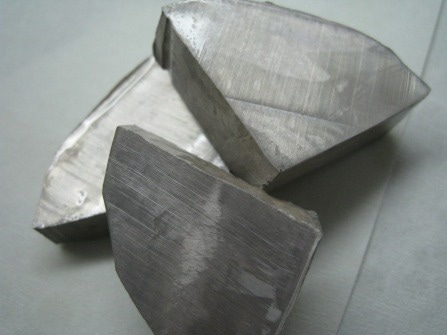Matter undergoes atomic-level alterations as it descends far enough under the surface of the Earth or into the center of the Sun.

A University at Buffalo-led study analyzes the chemical binding behind sodium’s transformation from shiny metal to transparent insulator under high pressure. Image Credit: Dnn87, Creative Commons Attribution-Share Alike 3.0 Unported
Metals have the potential to become nonconducting insulators due to the increasing pressure within stars and planets. Squeezing sodium hard enough has been proven to change it from a lustrous, gray metal into a transparent, glass-like insulator.
The chemical bonding of this specific high-pressure phenomenon has now been uncovered by a study headed by the University of Buffalo.
The electrons in sodium are believed to be essentially squeezed out into the gaps between atoms by high pressure; however, quantum chemical calculations performed by researchers reveal that these electrons are nonetheless chemically connected to the surrounding atoms and remain a part of them.
We are answering a very simple question of why sodium becomes an insulator, but predicting how other elements and chemical compounds behave at very high pressures will potentially give insight into bigger-picture questions. What is the interior of a star like? How are planets’ magnetic fields generated, if indeed any exist? And how do stars and planets evolve? This type of research moves us closer to answering these questions.
Eva Zurek, Professor, Chemistry, College of Arts and Sciences, University at Buffalo
The research validates and advances the theoretical forecasts of the late, well-known physicist Neil Ashcroft, to whose honor the study is dedicated.
Until Ashcroft and Jeffrey Neaton’s groundbreaking study two decades ago revealed some materials, like sodium, can become insulators or semiconductors when squeezed, it was believed that materials always became metallic under high pressure—like the metallic hydrogen suggested to make up Jupiter's core.
They proposed a theory that, under a high-pressure situation, the supposedly passive core electrons of sodium would interact with the outer valence electrons and with one another.
Our work now goes beyond the physics picture painted by Ashcroft and Neaton, connecting it with chemical concepts of bonding.
Stefano Racioppi, PhD, Study Lead Author and Postdoctoral Researcher, Department of Chemistry, University of Buffalo
The scientists used supercomputers at UB's Center for Computational Research to do simulations on how electrons behave in sodium atoms under high pressure, as it could be challenging to duplicate the pressures present under Earth’s crust in a lab.
An electride condition occurs when electrons become trapped within the interspatial areas between atoms. As free-flowing electrons absorb and retransmit light, trapped electrons simply let the light pass through, causing sodium’s physical transition from sparkling metal to translucent insulator.
Nevertheless, calculations made by the researchers revealed for the first time that chemical bonding can account for the development of the electride state.
Electrons in their respective atoms take up new orbitals due to the high pressure. Thereafter, these orbitals cross across to create chemical bonds, which result in localized charge concentrations in the interstitial spaces.
The new calculations revealed that the electrons are still a part of the surrounding atoms, contrary to the intuitive assumption put out by earlier research that suggested high pressure forced electrons out of atoms.
Racioppi added, “We realized that these are not just isolated electrons that decided to leave the atoms. Instead, the electrons are shared between the atoms in a chemical bond. They are quite special.”
Christian Storm and Malcolm McMahon from the University of Edinburgh’s Center for Science in Extreme Conditions and School of Physics and Astronomy are among the other contributors.
The study was funded by the Center for Matter at Atomic Pressure, a National Science Foundation institution managed by the University of Rochester that explores how pressure within stars and planets can affect the atomic structure of materials.
Zurek concluded, “Obviously it is difficult to conduct experiments that replicate, say, the conditions within the deep atmospheric layers of Jupiter but we can use calculations, and in some cases, high-tech lasers, to simulate these kinds of conditions.”
Journal Reference
Racioppi, S., et. al. (2023) On the Electride Nature of Na-hP4. Angewandte Chemie. doi:10.1002/anie.202310802